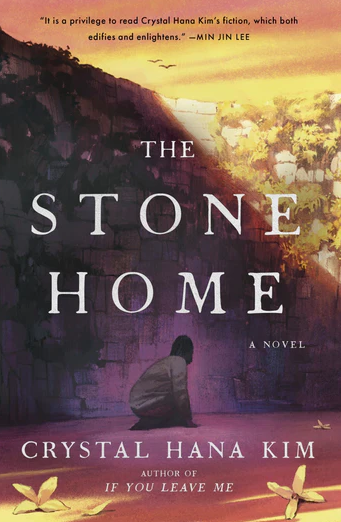The Stone Home: A Novel
- By Crystal Hana Kim
- William Morrow
- 352 pp.
- Reviewed by Terri Lewis
- May 15, 2024
A raw, disturbing tale of forced labor in 1980s South Korea.

Crystal Hana Kim’s The Stone Home begins in 1980 with a homeless mother and her daughter begging on the street in Gunsan, South Korea. When police come, the daughter, Eunju, tries to slash their faces with a rock, but the two are cuffed and hauled away.
Flash-forward to 2011: Eunju opens her door to an American woman who speaks fluent Korean and wields a black knife Eunju hasn’t seen in decades. She’s been sent by her dying father to discover the truth about his life. After some confusion and denial, Eunju realizes who the woman is and reluctantly lets her in, although she imagines “the blade slicing the skein that holds our world together, the green gush of the past pouring through.”
The novel limns a mostly unknown episode in Korean history during which women and children — vagrant or not — were forcibly taken from the streets and placed in what amounted to internment camps. These camps find an echo in recent reports of Indigenous Canadian children forced into residential schools, where they were abused. To read those stories is to feel disgust or anger, but at a distance. Kim’s novel, however, refuses to provide such distance. Instead, the reader is immersed in the daily torture and degradation inflicted for reasons unknown.
The mother and Eunju arrive at the camp/home at the same time as two brothers. The pairs mirror one another — each contains a fighter: Eunju, battling against her mother’s reluctance to escape, and Sangchul, the protector of his elder sibling. Alternating chapters focus on each pair and track the monstrous system that frays and ultimately severs family ties.
In the beginning, the boys, kept separate from the girls, are made to create and package items like fishhooks and belts. They have strict production quotas; if the boys miss them, they are violently disciplined. The older boys who oversee the work are called Keepers and have suitable nicknames — Cow, Crow, and the inevitable Rat. They carry white bats for beating their charges either to keep them in line or just because.
The girls and women have it somewhat easier, cooking and cleaning under the eye of Halmoni, a woman with a goiter. The home is run by two shadowy, powerful men — Teacher and Warden — who don’t blink when applying the switch or other punishments.
The boys quickly form a group, vowing to protect each other. Some of them hope to rise up through the ranks, as it were, and become Keepers, a role that degrades but also shields. But no matter their rank, pain always comes. The girls are more wary, slow to protect their own, although Eunju makes a friend, her first, in Mina.
One day, Eunju and Mina are put into Sangchul’s workshop. Although the abuse doesn’t ease, the girls are refreshing distractions, and some calm moments ensue (both for them and for readers). Eunju proves to be the quickest worker, easily surpassing quota and earning a reward: a short walk around the grounds, during which she plots her escape.
Jealousies emerge; a fishhook pierces a hand; Eunju refuses to give up some of her product (and the reward) to help Mina, who has fallen behind; and Mina is savagely beaten. When Sangchul’s brother declines to batter another boy, he expects Sangchul’s defense. Instead, Sangchul hangs back. The brother himself is beaten and taken away to Chapel, a secret place from which boys return with fractured bodies and broken minds. In the midst of this chaos, an inspector visits, with tragic results. Soon, Sangchul begins to disintegrate.
Via intermittent chapters set in 2011, the reader comes to understand who the knife-wielding woman at Eunju’s door is, but not who her father is or how he relates to Eunju. Author Kim’s superb writing is subtle, elliptical, and demanding of close attention. Sometimes, it offers a glimmer of beauty:
“Time passed in layers, until the moon slid past the porthole window, and I looked down. My yellow shirt was damp with sweat. Tears. The cotton clung to my ribs, revealing a river of bones.”
At other times, the prose terrorizes, refusing to let up on such in-your-face cruelty as here, when a child is made to lick Warden’s shoe:
“I opened my mouth. Animal meeting animal. Silt and salt collecting on my tongue. The laces waxy. My stomach roiled, and I swallowed a well of vomit.”
As the story progresses, the reader is immersed in thrashings, starvation, destroyed eyes, and psychological torment. The young inmates gradually unravel, first abandoning their natural family, and then their found family forged in captivity. The relationship between Eunju and Sangchul, too, sharpens and festers before reaching an explosive, ferocious conclusion.
The Stone Home aims to break down the self-protective distance that forms when one learns about a tragedy, to move the reader beyond thinking and into feeling. In that, it succeeds. But approach this novel with caution: You’ll be right there, suffering alongside the characters on every page.
Terri Lewis is a writer living in Denver, Colorado, with her husband and two entertaining dogs. Her debut novel, Behold the Bird in Flight, about the abduction and coming to power of Isabelle, King John’s second wife, will be published next year.

